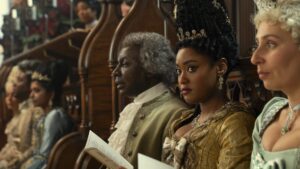
With news of Bridgerton Season three still seemingly far in the future, fans of the series are yearning for more. And Queen Charlotte: A Bridgerton Story has delivered. While the Bridgerton source material spurned various spin-offs and prequels, Queen Charlotte delves into an area of the world that Julia Quinn has never previously attempted—that of the Queen’s history.
The show’s premise revolves around the young Charlotte (India Amarteifio), as she begins her life with King George III (Corey Mylchreest), with a parallel storyline of Queen Charlotte in the era of Bridgerton (Golda Rosheuvel). It’s a show that feels somewhat more sombre and melancholic than its predecessor, with a maturity that surpasses that of Bridgerton. However, a lot of Queen Charlotte’s success comes from elements that are present in the original show, but expanded upon. In this article, see some of the key aspects of Bridgerton that its spin-off refines.
The Reluctant Romance Trope
Over the course of Bridgerton’s first two series, we’ve seen some classic romance tropes incorporated. We saw Daphne and Simon (Phoebe Dynevor and Regé-Jean Page) embody the fake dating trope, while Anthony and Kate (Jonathan Bailey and Simone Ashley) undertook the slow burn journey of enemies-to-lovers. And now, with Charlotte and George, we see another variation of the reluctant romance trope: an arranged marriage. Across their love stories, the build-up stirs such passionate audience reactions when a love confession inevitably occurs, though Queen Charlotte has done it best.
In the new Bridgerton story, the reluctance comes from factors that go undiscovered for much of the narrative; this echoes Anthony’s arc, since his coldness towards marriage arises from factors beyond the woman in front of him. Rather, it’s the weight of familial responsibility, and his response to his father’s death. For George, it’s the recognition that due to his mental illness, he cannot provide the life he would want for his partner. The beauty in this romance however, comes from Charlotte’s willingness to take on that burden, and the tenderness that blooms between them in this choice. In Bridgerton, the King is only glimpsed. Though, the Queen’s adoration is made clear. Queen Charlotte reveals the very start of their story, showcasing their process to love. The satisfaction comes from the journey, and where it started—in this case, a charming conversation that takes place while one party is trying to run away from their wedding.

An Ensemble with Chemistry
Queen Charlotte delivers on showcasing strong chemistry. The frenetic energy and connection between Corey Mylchreest and India Amarteifio makes them shine together, and when you watch Queen Charlotte press junkets, it is clear that this connection and warmth is fostered by a solid friendship off-screen. This builds on the friendships and chemistry we have seen developed between the Bridgerton cast.
The Bridgerton stories have become renowned for their steamy sex scenes, and in particular, the appeal to the female gaze. Queen Charlotte is no different, with the chemistry between the romantic leads being as physical as it is emotional. Charlotte discovers her sexuality for the first time, much like Daphne in Bridgerton, but this exploration doesn’t repeat that narrative, offering new story beats and a different kind of sexiness.
However, Bridgerton also recognises that platonic chemistry is equally important, and these relationships are given the same attention and care. In the original series, this is mainly explored through the relationships between the Bridgerton siblings. Although there aren’t any sibling relationships dominating the screen in Queen Charlotte (though the Queen herself has a brother, Adolphus), the sisterhood between Lady Danbury (Arsema Thomas and Adjoa Andoh) and Queen Charlotte is keenly felt. The same can be said of the unfaltering loyalty of Brimsley (Sam Clemett) to Charlotte. Much like Penelope and Eloise’s (Nicola Coughlan and Claudia Jessie) friendship in Bridgerton, these relationships’ effects on these characters majorly impacts how they traverse the series. However, in Queen Charlotte it’s not only impactful, but essential to how Charlotte understands her place in this new world. If anything, her dynamics with Agatha and Brimsley are as important to the narrative as the romance at its centre.
Strong Female Characters
The romance genre and depictions of ‘strong female characters’ often come into conflict. To be a strong woman on screen, is to demonstrate that you don’t need a man. However, Bridgerton understands that you can still have fully realised female characters who desire relationships and thrive in them, and to be a strong female character doesn’t require you to be a moral person. The women in Bridgerton and Queen Charlotte often commit mistakes that hurt the people around them, or make the audience uncomfortable (Penelope’s Whistledown columns lead to the public ruin of her best friend, for example). However, the Bridgerton world curates these female characters with the agency to make those decisions for themselves. The women of Queen Charlotte continue this trend, showcasing multiple sides to themselves: Charlotte and Agatha are allowed to dance and laugh, and want to impress the people around them; they are allowed to get angry and frustrated and bitter; they can be cruel as well as kind. They embody many different ways of being a woman, both in contrast to each other and other women in the series such as Violet (Ruth Gemmell and Connie Jenkins-Greig) or Princess Augusta (Michelle Fairley).
